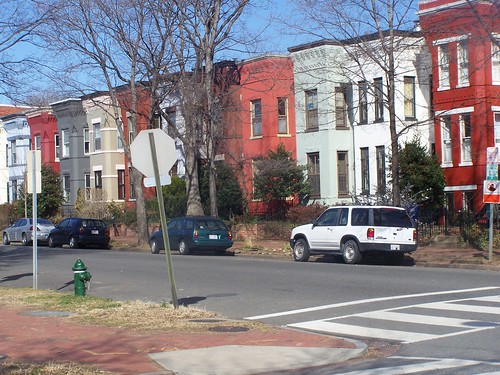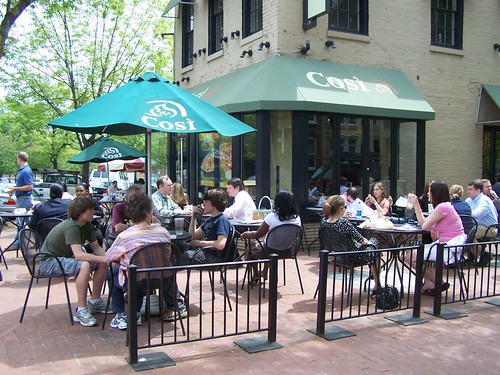The economics of the housing market are very simple: Demand greater than supply increases price as DC demonstrates
A colleague sent me a link to this Post Wonkblog piece, "How high-cost housing conquered D.C. in a single decade," discussing an Urban Institute study about DC's rapid rise in housing costs, despite an increase in supply.
I don't understand the shock, maybe the hand-wringing, but I can't think of why anyone would consider the findings to be unusual, other than that people don't understand how much the DC housing market has changed since 2000.
The rise in prices is a very basic illustration of the principles of economics working, in this case within the housing market, when demand increases.
From the article:
Back in 2005, before the new apartments went up in NoMa, and along 14th Street, and near the Nationals' ballpark, there was more housing in D.C. renting for less than $500 a month than for more than $1,500*. In the decade since, fortunes at the top and bottom of the city's housing market have swiftly flipped. By 2012, the most expensive rental units outnumbered the cheapest ones — by more than a three-to-one ratio.
The changing shape of the city's housing over this short time reflects two powerful trends that are playing out in other big cities, too: Housing that was once more affordable has grown less so, while most of the new housing that's been built has catered to wealthier (and newer) residents.When you can't increase supply significantly, prices go up. In the last 15 years, demand for living in DC has increased significantly, especially for single family housing, especially in buildings constructed before 1940 and considered "historic."
 300 block of 12th Street SE, Capitol Hill, Washington, DC.
300 block of 12th Street SE, Capitol Hill, Washington, DC.For the most part, in DC it is impossible to increase the supply of single family housing, because the city's residential districts are mostly developed and have been for decades.
And for obvious reasons, it's impossible to build more "historic" housing stock (although EYA does a pretty good job of producing new rowhouses with facades that match pre-1915 Victorians).
So prices increase even with a minimal increase in demand.
For example, in my neighborhood, houses that sold for under $400,000 six years ago are now selling for about $600,000 today (of course, each sale has particular circumstances that shape the final price, and higher priced houses have been renovated).
In situations of hyperdemand, when supply increases, prices still go up. Even when you increase supply, if demand is greater still, prices will continue to rise. This is definitely the case in high demand neighborhoods all around the US (e.g., Brooklyn Heights, many neighborhoods in San Francisco ["As Housing Costs Soar, San Francisco Seeks Ballot Solution," New York Times], etc.).
Chancellor's Row development by EYA in the Brookland neighborhood of Northeast DC.
Single family housing market. Some opportunities for adding SFH have been realized in odd situations here and there across the city.
Some examples that come to mind include the Methodist Home redevelopment at Peabody and New Hampshire Ave. NE, and various projects by EYA including acquisition of the old Children's Hospital site and its redevelopment into rowhouses in the U Street neighborhood, the Bryan School redevelopment into condominiums on Independence Avenue SE, where land on the site (playground, etc.) was redeveloped as rowhouses, or the acquisition of land on the edge of the St. Paul's College campus in Brookland, which was redeveloped as the Chancellor's Row rowhouse complex, etc.
While I don't have an exact number, in the core of the city, maybe this has produced as much as 1,000 units of new housing (excluding Capper-Carrollsburg in SE south of the freeway).
Note that this excludes from consideration a significant expansion of single family housing constructed East of the River, mostly produced by the WC Smith Company ("Why Did Developer WC Smith Buy Up Most of Congress Heights," Washington City Paper).
Some displacement from the conversion of rental housing. As I wrote in various pieces about 10 years ago, about "gentrification" ("More about contested spaces--gentrification"), one of the effects of increased demand is some displacement, as rental housing is converted to owner occupied housing, both of single family housing as well as the conversion of small apartment buildings to condominiums.
In the early stages of the city's resurgence this was less of a factor, because many of the re-occupied houses had been vacant previously, often for many years if not decades.
When you increase the supply of multiunit housing, prices still go up because of the level of demand and the cost to build it. The addition of multiunit housing meets demand for a different segment of the market, one that in DC was underserved. (You could argue that DC had been over-supplied in single family housing).
For the most part, new housing targets the highest value segments of the market, because of the cost of construction and land. And it is priced accordingly.
Because of the level of demand for urban living reflecting a shift in consumer preferences, the increase in supply--even though high--hasn't significantly reduced prices (also see "Despite a Crush of Class A Units, Rents Rise in the District," Urban Turf).
As an aside, recently I heard that the new, very expensive condominiums and apartments at CityCenterDC in the heart of Downtown, are 85% occupied, less than one year after coming on the market.
The height restriction limits supply also. In the high in demand submarkets in the city, in Northwest especially but also in Northeast DC around Union Station and in Southeast, around Capitol Hill, the height restriction on buildings (buildings can only be constructed to a height of about 160 feet or less, depending on specific local conditions) makes housing more costly on a per square foot basis.
So while adding new supply seems like it should lead to a brake on price increases, it ends up not doing so because the amount of housing added is still less than that needed to satisfy demand.
Taller buildings would have more units and would leverage the transit infrastructure already present, and it'd probably lead to some stabilization in rental prices.
One such example is the Takoma Central development, which is one long block away from the entrance to the Takoma Metrorail station. Most of the Takoma Central development is four stories, with one small section topping out at five stories.
Developing this site at five- or six-stories would have added a few dozen more units.
Multiply such an increase across similar sites across the city, and hundreds more units of new housing could be added, which would add to supply in a manner more likely to limit price increases in the near and longer terms.
The first to be constructed apartments at Fort Totten (right) are four story buildings. A building at South Dakota Avenue and Riggs Road under construction now is 6 stories.
Maintaining rental housing affordability requires different strategies, but can't hold back change. In the high-in-demand neighborhoods, it is going to be impossible to maintain lower priced single family housing as an element of the rental market.
But by adding multiunit housing where it can be accommodated and augmenting the inventory of accessory dwelling units, more housing could be provided, and over time it will provide lower cost options and access to "higher quality" neighborhoods by lower income households.
It's easiest to maintain lower cost multiunit housing by ensuring that it is purchased and owned by nonprofits and for profits committed to maintaining long term affordability. Property acquisition assistance could be provided on a bigger scale to keep older properties affordable, rather than allowing them to be sold and repriced.
Adding more "affordable housing" requires subsidies and available land. These days, DC has a fair amount of money to assist in the production of affordable housing. And while there are some bureaucratic elements to the Housing Production Trust Fund program that make using the monies difficult, the real difficulties aren't about paperwork.
First, there aren't all that many development opportunities--there isn't that much land to redevelop. That's why most multiunit projects are in commercial districts and "reuse" sites that had been low density retail.
Photo of the Hebrew Home for the Aged from the Park View DC blog.
Current residents often oppose new developments, more density, and affordable housing "for those people." Second, when there are opportunities to use city-owned and other institutionally controlled properties to develop affordable housing primarily, rather than market rate housing, residents frequently oppose such projects.
We are seeing this in the response to proposals to redevelop the vacant Jewish Home for the Aged on Spring Street NW in Columbia Heights, where many residents oppose the proposal.
The site is well located, a few blocks--0.3 miles away--from the Petworth Metro station and a new Safeway supermarket. It would be a perfect location and way to add affordable housing to a community that is losing such housing.
Sometimes problems are unfixable. Just as in Vietnam when Generals talked about the necessity of "destroying villages in order to save them," ultimately the only way all the people who want to live in DC could be accommodated cost-effectively in the long term would be to tear down low density residential housing and rebuild it over as large apartment and condominium buildings.
 But that would destroy most if not all of the qualities that are attracting people to the city.
But that would destroy most if not all of the qualities that are attracting people to the city.Labels: affordable housing, housing market, public/social housing, real estate development, urban economics








4 Comments:
Very good job Richard
excellent posting and response to this perceived problem- som ecities would love to have our "problems" here in DC. One questions what kind of rock the author of this naive sounding article has been living under or what exurb they are from........
1. Velocity can be more important in price perceptions than absolute change. People can remember paying 250 in rent. That isn't coming back, but it is recent memory.
2. Picking the starting date is key. 2005? Pretty late into the recovery. 1998? 1992? 1985?
DC has a lot of submarkets. The market for condos in gentrifying areas really exploded after 2005. Georgetown has been on a upswing since FDR. EOTR has probabbly been on a downswing since 1965. Calling it all one market is pretty lazy.
3. Tenant protection. Tenant protections are probably the biggest problem in DC right now, as there is little incentive to upgrade older units. Combine that with the section 8 price floor and it is hard to get something decent for under 1600.
That is what microunits are about -- building units for 1000 a month rents that ghetto people won't want to move into.
For people who are employed and can get a mortgage DC is reasonably afforable. You can get into a 2BR condo for well under 700K.
If you want a house after that, you are priced out of the nice areas of the city. Ward 4 and 5 prices are getting a bit silly for what you get. I definitely agree that some of the 900K houses for sale in Arlington are crazy, but you are getting a school.
nice information and Have a medicine website. there is a medicine that seems to work, please check out website.Take this medicne as advised by the doctor that are easily available at the online medicine store in USA.
Post a Comment
<< Home